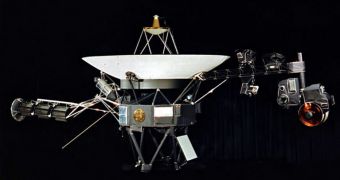The Voyager 2 spacecraft is one of NASA's landmark missions, and the second reiteration of the successful Voyager 1 mission. The space probe is currently located no less than 8.6 billion miles (13.8 billion kilometers) away from our planet, at the very edge of the solar system. It is constantly sending new data to its mission controllers, and has been doing so without hesitation for about 33 years. But recently, engineers caring for the flight noticed an anomaly in Voyager 2's communication patterns, which prompted them to take action, Space reports.
The team has just issued a new set of commands to the distant space probe, which instructs its onboard computer to only send back data on its health status. Experts are fairly optimistic that everything is in good shape, as a report Voyager 2 sent back on May 1 showed that all systems were functioning within their optimal parameters. The NASA engineers say that the error appeared in the spacecraft's flight data system, which is responsible for encoding the data the probe collects, before sending them home. The updates are sent in a particular pattern that has been altered during the last transmission.
The error is not without consequences. Due to the scrambled patterns, the researchers now find themselves in a position where they cannot readily decode the formatting of the data sent home. “Voyager 2's initial mission was a four-year journey to Saturn, but it is still returning data 33 years later. It has already given us remarkable views of Uranus and Neptune, planets we had never seen close-up before. We will know soon what it will take for it to continue its epic journey of discovery,” explains Ed Stone, the Voyager project scientist. He is based at the California Institute of Technology.
NASA's Deep Space Network of listening antennas first picked up on clues that a problem may be plaguing Voyager 2 on April 22, when the first scrambled patterns were received. Over the following week, programmers developed new code, which they then began relaying to the probe on April 30. However, it takes about 30 hours for a signal to be sent to the robotic explorer and back, due to the massive distance that separates it from Earth.

 14 DAY TRIAL //
14 DAY TRIAL //